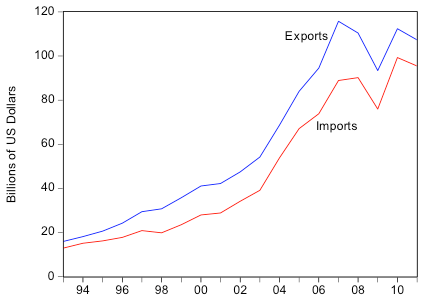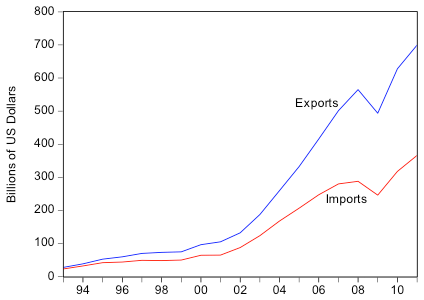| Author Name | THORBECKE, Willem (Senior Fellow, RIETI) |
|---|---|
| Research Project | East Asian Production Networks and Global Imbalances |
| Download / Links |
This Non Technical Summary does not constitute part of the above-captioned Discussion Paper but has been prepared for the purpose of providing a bold outline of the paper, based on findings from the analysis for the paper and focusing primarily on their implications for policy. For details of the analysis, read the captioned Discussion Paper. Views expressed in this Non Technical Summary are solely those of the individual author(s), and do not necessarily represent the views of the Research Institute of Economy, Trade and Industry (RIETI).
International Macroeconomics Program (FY2011-FY2015)
East Asian Production Network and Global Imbalances Project
China's trade surplus is entirely in processing trade. Processed exports are final goods produced using parts and components coming from East Asian supply chain countries. Many have argued that because much of the value added of China's processed exports comes from East Asian countries, exchange rates in supply chain countries should affect China's processed exports while the renminbi should not. This paper investigates these issues by considering the two main subcategories of processed exports: processing and assembly (PAA) exports and processing with imported materials (PWIM) exports. Figure 1a shows that the lion's share of the value of PAA exports comes from PAA imports that are produced in supply chain countries. Figure 1b shows that a substantial gap has opened up between the value of PWIM exports and PWIM imports, indicating that much of the value added of PWIM exports comes from China. In addition, since PWIM imports are large, much of the value added of PWIM exports also comes from supply chain countries. Evidence presented in this paper indicates that East Asian exchange rates affect both types of exports and that the renminbi significantly affects PWIM exports but not PAA exports. These results are what one would expect since supply chain countries contribute most of the value added to PAA exports and since both China and supply chain countries contribute substantially to the value added of PWIM exports. Since PWIM exports are now six times the value of PAA exports, these results indicate that the renminbi matters for total processed exports (i.e., the sum of PAA and PWIM exports).
While exchange rates in both China and other East Asian countries thus matter, there is little discussion between East Asian policy makers on exchange rate issues. This lack of official interaction contrasts with the intensive private sector integration occurring within regional production networks. East Asian government officials should begin a dialogue behind closed doors on exchange rate issues. This discussion could include the problems of further reserve accumulation, the desirability of a joint appreciation relative to the U.S. dollar, and ways to limit exchange rate volatility in the region. Hopefully, these behind the scenes interactions by economists and trained officials could point to a vision of how exchange rate policy in the region should evolve.
FIGURE 1a
Value of China's Processing and Assembly (PAA) Exports and Imports, 1993-2011

Source: CEIC Database
Note: Values for 2011 are estimates based on data for the first 8 months of 2011
FIGURE 1b
Value of China's Processing with Imported Materials (PWIM) Exports and Imports, 1993-2011

Source: CEIC Database
Note: Values for 2011 are estimates based on data for the first 8 months of 2011

